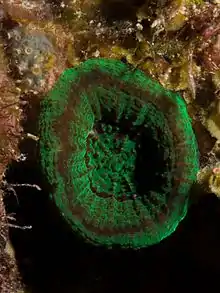| Scolymia | |
|---|---|
 | |
| Scolymia cubensis | |
| Scientific classification | |
| Domain: | Eukaryota |
| Kingdom: | Animalia |
| Phylum: | Cnidaria |
| Class: | Hexacorallia |
| Order: | Scleractinia |
| Family: | Mussidae |
| Genus: | Scolymia Haime, 1852 |
| Species | |
|
See text | |
| Synonyms | |
| |
Scolymia, commonly called scoly coral, is a genus of large-polyp stony corals (Scleractinia). These animals are believed date back to the Miocene with three extant species present in the eastern Atlantic Ocean.[1][2]
Description
Unlike most other Scleractinia, Scolymia are solitary corals. Polyps can grow up to 10 cm in diameter. Morphology is diverse with both interspecific and intraspecific variation in shape.[3] Polyps may be concave, convex, or flat depending on the species and environmental conditions. Species are generally distinguished based on differences in septa number, thickness, and orientation.[3] Scoly corals range from brown to bright fluorescent greens, reds, and purples.
Members of this genus are commonly found in reef aquariums because of their slow growth,[2] however separation from other corals is necessary due to intense competition.[4] The slow growth rate of these corals is not well understood, but researchers have proposed that cyanobacterial mats may inhibit their growth or even cause shrinkage.[2][5]
Ecology
Energy
Scolymia harness their energy mainly through a symbiotic relationship with zooxanthellate, a group of photosynthetic dinoflagellates. To a lesser degree, these corals can also feed heterotrophically using their tentacles to catch plankton drifting through the water at night.[2][3]
Habitat and geographic distribution
All Scolymia species are located in the Atlantic Ocean along the east coast of the Americas between Florida, through the Caribbean sea and Gulf of Mexico, and as far south as Brazil.[2][4] At higher latitudes, Scolymia tends to grow faster compared to at lower latitudes, likely as a result of annual mean temperature differences.[5] Scoly corals are typically found at the base of a reef between 10-80 m deep where there are turbid waters with low-light conditions.[6] Scolymia anchor in soft substrates where sediment continuously accumulates. They have adapted sediment-shifting abilities by growing upward on nearly-vertical surfaces in addition to a mucus exterior that prevents sedimentation from above.[2] This adaptation has allowed Scolymia to fill an ecological niche in which other corals are not able to survive.
Predation
Scoly corals have a unique ability to avoid both disease and predation from coralivorous fishes. The reasons for this are still largely unknown, however, it is believed that their bold colors may deter predators.[5][2]
Conservation status
According to the ICUN Red List, the conservation status of Scolymia cubensis[7] and Scolymia lacera[8] is Least Concern, and Scolymia wellsii is data deficient.[9] While there are no specific known threats to Scolymia, corals in general are sensitive to rising temperatures brought on by climate change, resulting in coral bleaching. It is possible that Scolymia, relatively deep habitat preference helps protect it from temperature-related damage.
Behavior
Interspecific competition
Some scoly corals are known to exhibit interspecific aggression by attacking both congeneric species and other corals, causing them to expel their zooxanthellates. Generally, S. lacera defeats and kills S. cubensis.[1][4][10]
Reproduction
Scolymia reproduce sexually through broadcast spawning. Because of their lack of immune-recognition, it is possible for gametes from the same individual to fertilize each other, resulting in less genetic diversity.[1] Fertilized planktonic larvae drift through the current before settling on a reef bed.
Intraspecific fusion
When two or more Scolymia cubensis larvae settle near one another, they usually fuse together to form one complex coral with distinct genotypes.[1]
Taxonomy
Species[11]
The World Register of Marine Species includes the following species in the genus:
- "Artichoke coral" Scolymia cubensis (Milne Edwards & Haime, 1848)
- "Atlantic mushroom coral" Scolymia lacera (Pallas, 1766)
- "Solitary disk coral" Scolymia wellsii (Laborel, 1967)
Other species were previously classified under Scolymia but have since been reclassified to distinct genera:
- Cynarina lacrymalis - Basionym: Scolymia lacrymalis (Milne Edwards & Haime, 1848)
- Homophyllia australis - Basionym: Scolymia australis (Milne Edwards & Haime, 1848)
- Lobophyllia vitiensis - Basionym: Scolymia vitiensis (Brüggemann, 1877)
References
- 1 2 3 4 Logan. (1988). Budding and Fusion in the Scleractinian Coral Scolymia Cubensis (Milne Edwards and Haime) from Bermuda. Bulletin of Marine Science, 42(1), 145–149.
- 1 2 3 4 5 6 7 Coni, E.O.C., Ferreira, C.M., Meirelles, P.M. et al. Modeling abundance, growth, and health of the solitary coral Scolymia wellsi (Mussidae) in turbid SW Atlantic coral reefs. Mar Biol 164, 66 (2017). https://doi.org/10.1007/s00227-017-3090-4
- 1 2 3 Wells. (1971). Note on the Scleractinian Corals Scolymia Lacera and S. Cubensis in Jamaica. Bulletin of Marine Science, 21(4), 960–963.
- 1 2 3 Lang, Judith (1971-10-01). "Interspecific Aggression by Scleractinian Corals. 1. The Rediscovery of Scolymia Cubensis (Milne Edwards & Haime)". Bulletin of Marine Science. 21 (4): 952–959.
- 1 2 3 Tomascik, T.; Logan, A. (1990-05-01). "A Comparison of Peripheral Growth Rates in the Recent Solitary Coral Scolymia Cubensis (Milne-Edwards and Haime) from Barbados and Bermuda". Bulletin of Marine Science. 46 (3): 799–806.
- ↑ Reed JK (1985) Deepest distribution of Atlantic hermatypic corals discovered in the Bahamas. Proc 5th Int Coral Reef Symp 6:249–254
- ↑ Aronson, R., Bruckner, A., Moore, J., Precht, B. & E. Weil. 2008. Scolymia cubensis. The IUCN Red List of Threatened Species 2008: e.T133053A3582924. https://dx.doi.org/10.2305/IUCN.UK.2008.RLTS.T133053A3582924.en. Accessed on 14 April 2022.
- ↑ Aronson, R., Bruckner, A., Moore, J., Precht, B. & E. Weil. 2008. Scolymia lacera. The IUCN Red List of Threatened Species 2008: e.T132874A3471788. https://dx.doi.org/10.2305/IUCN.UK.2008.RLTS.T132874A3471788.en. Accessed on 14 April 2022.
- ↑ Aronson, R., Bruckner, A., Moore, J., Precht, B. & E. Weil. 2008. Scolymia wellsi. The IUCN Red List of Threatened Species 2008: e.T133605A3824582. https://dx.doi.org/10.2305/IUCN.UK.2008.RLTS.T133605A3824582.en. Accessed on 14 April 2022.
- ↑ Colin, Patrick L. (1988). Marine invertebrates and plants of the living reef. T.F.H. ISBN 0-86622-875-6. OCLC 19126207.
- ↑ Vanden Berghe, Edward (2018). "Scolymia". WoRMS. World Register of Marine Species. Retrieved 2018-08-15.